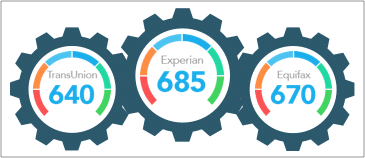When it comes to paying off your federal student loans, finding the right repayment plan can be a confusing and overwhelming option. But when it comes down to it, there’s no one-size-fits-all best repayment plan out there – it all depends on your specific financial goals, needs, and the types of loans you have.
So first, we’ll take a look at the different types of plans available, then we’ll look at how they fit your financial needs.
What are the Different Repayment Plans?
Depending on your loan and financial situation, you’ll have several different repayment options available to you. Here are the fast facts about the options offered to federal loan borrowers:
Standard Repayment Plan
You’ll automatically be enrolled in the standard repayment plan when your repayment period starts unless you’ve already selected another option. This is typically a 10-year term, the shortest of all available plans, but it may be longer if you consolidate your loans. Payments are fixed and remain the same for the entire term and all federal student loan borrowers are eligible.
Graduated Repayment Plan
The graduated repayment plan is similar to the standard repayment plan as it typically has a 10-year term that can be extended to a 30-year term if you consolidate your loans. But with this plan, you’ll start with lower monthly payments that increase at regular intervals – typically every 2 years. This makes it a good choice if you want to pay off your loans quickly, but are starting off with a low income that you expect will increase with time. All federal student loan borrowers are eligible for this repayment plan.
Extended Repayment Plan
The extended repayment plan lets you extend your repayment term to 25 years. You’ll have the option to choose between fixed or graduated payments. You must have at least $30,000 in federal student loan debt in order to qualify for the plan.
Revised Pay As You Earn Repayment Plan (REPAYE)
With the REPAYE plan, your monthly payment is 10% of discretionary income. This income is calculated by finding the difference between your annual household income and 150% of the poverty guideline based on your family size and state of residence. Your payment amount will be recalculated every year to account for changes in your income and family size. It’s important to know that there is no cap to how high these payments can be – so if you have a high income your payments could be higher than they would be on the standard payment plan.
With REPAYE, your repayment term will be extended to 20 or 25 years depending on the specific loan you have. At the end of this term, any amount that you have not paid off will be forgiven, but that amount could be considered taxable income. Parents who take out PLUS loans are not eligible for this repayment plan, but most other borrowers are.
Pay As You Earn Repayment Plan (PAYE)
The PAYE plan also sets your monthly payment amount at 10% of your discretionary income, but unlike the REPAYE plan, your monthly payment amount is capped. The amount you pay will never be set higher than what your payment would be on the standard repayment plan. This amount is recalculated every year, and will change as your income and family size changes.
The repayment period is extended to 20 years with the PAYE plan. To qualify, you must have a high debt to income ratio, and parents with PLUS loans are not eligible.
Income-Based Repayment Plan (IBR)
Depending on when you first took out your loans, the IBR plan will set your monthly payment amount at 10% or 15% of your discretionary income. Your payment amount is capped at the amount you would be paying on the 10-year standard repayment plan, regardless of how high your income is.
As with other income-based repayment plans, your payment amount is recalculated every year. Your repayment term is also dependent on when you received your loans and will either be set to 20 or 25 years. Any amount you haven’t paid may be forgiven at the end of this term. To qualify, you must have a high debt to income ratio, and parents with PLUS loans are not eligible.
Income-Contingent Repayment Plan (ICR)
With the ICR plan, you’ll either pay 20% of your discretionary income or the amount you would pay on a 12-year fixed payment plan adjusted to your income – whichever amount is less will be your monthly payment amount. This amount will be recalculated each year with the remainder forgiven at the end of the repayment term.
All federal student loans are eligible for this plan, including parents with PLUS loans. There’s no need to prove your financial need to qualify.
Income-Sensitive Repayment Plan (ISR)
The ISR plan is available to low-income borrowers who have Federal Family Education Loan (FFEL) Program loans. While these loans are no longer awarded, you can qualify for the plan if you still have FFEL plans to repay. The monthly payment amount is 20% of your discretionary income and is recalculated every year.
What’s the Best Repayment Plan for Me?
With so many options available, trying to determine which repayment plan is best for you can be overwhelming. First, you should visit the Department of Education to find out which plans you qualify for. Then, you’ll want to evaluate your financial goals and needs to find your best option.
Here are a few common financial goals and the plans that best complement them.
Goal: Lower Monthly Payments
Any one of the income-based repayment plans will usually lower your monthly payment amount. Even as your income changes, your payments will be adjusted to keep your payment amount at an affordable amount throughout the entire repayment term, in some cases even going as low as $0 per month. Just keep in mind that extending the term of your loan will result in paying more interest over time.
Goal: Lower Interest
The U.S. Department of Education sets the interest rate on federal loans and doesn’t offer a way for borrowers to lower that interest rate. However, if you pay your loans off quicker, they will accrue less interest. While you can prepay your loans on any repayment plan, a standard or graduated repayment plan may be your best option in this case. Be sure to indicate that you want to apply any extra payments towards the principal and not your next monthly payment.
Goal: Loan Forgiveness
If you qualify for the Public Service Loan Forgiveness program as a government or nonprofit employee, you’ll want to choose an income-driven repayment plan to save as much money as possible. In order for your debt to be forgiven with this program, you need to make 120 qualifying payments. If you were on the standard 10-year repayment plan, you’d already be done paying off your loans at this point, but there may be an amount left if you were paying lower monthly amounts based on your income.
Consolidating and Refinancing Your Student Loans
If you have a complicated repayment plan because of multiple loans, you can consolidate them to simplify your monthly payments. However, consolidating with your federal servicer will lead to a higher interest rate. Your new interest rate is the weighted average of the interest on the loans you’re consolidating, rounded up to the nearest one-eighth of 1 percent.
Depending on your income and credit history, you may be able to refinance your federal student loans with a private lender which could get you a lower interest rate. However, refinancing with a private lender will cause you to lose access to federal benefits like loan forgiveness and income-driven repayment plans.
Things to Keep in Mind
- You Can Switch Plans: If you find that a different repayment plan would suit you better as your financial situation changes, you can switch at any time. There is no fee or penalty for switching plans, and there’s no limit as to how many times you can switch.
- Plans Can Change: Keep in mind that all repayment plans are subject to change at any time per the Department of Education.
- You Can Hire Someone to Help: While you are free to enroll in any plan yourself on the Student Aid website, you can hire a student loan debt relief company to help you navigate any complex paperwork.
- Student loans from private lenders don’t qualify for any of the federal repayment plans: However, if you’re having trouble making the monthly payments you should call your lender to discuss your options. Some lenders have their own student loan repayment options that can reduce your monthly amount.
The Bottom Line
Finding the right repayment plan for your federal student loans is all about knowing what you qualify for and understanding your own goals and needs. While you can pay them off quickly with a standard or graduated plan to save on interest, you can also apply for a monthly lower payment that better fits your budget with an income-driven repayment plan.




